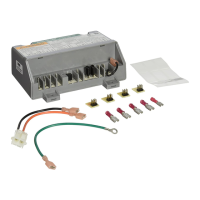— input voltage
— hot surface igniter
— gas control
— wiring
If the main burner lights, but goes out at the end of ignition trial, check the:
— igniter/sensor
— flame rod
— burner ground connections
— wiring
Two flashes indicates the flame rectification signal is weak.
The most probable causes are:
— contaminated or mislocated igniter/sensor or flame rod
— poor flame sense leadwire insulation or connections
— poor gas pressure
If the flame rectification signal is strong when the appliance lights, but weak while heat is being delivered, check
for overheating of the igniter/sensor, flame rod ceramic or flame sense lead wires.
Three flashes indicate an internal error. The most probable cause is an S8910U logic failure. Start a new call for
heat and if the three-flash signal returns, replace the S8910U.
Ignition System Checks
Step 1: Check igniter wire harness.
Make sure:
Ignition cable does not run in contact with any metal surfaces.
Connections to the ignition module and to the igniter or igniter-sensor are clean and tight.
Ignition cable provides good electrical continuity.
Step 2: Check ignition system grounding. Nuisance shutdowns are often caused by a poor or erratic ground.
a. A common ground is required for the module, igniter, flame sensor and main burner.
Check for good metal-to-metal contact between the igniter bracket and the main burner.
Check the ground path from the GND (BURNER) terminal on the module to the main burner. Make sure
connections are clean and tight. If the wire is damaged or deteriorated, replace it by following the appliance
manufacturer instructions. A temporary lead wire connection between the GND (BURNER) terminal and the
main burner can help confirm a ground path problem.
Check the temperature at the igniter ceramic or flame sensor insulator. Excessive temperature permits leakage
to ground. Contact the appliance manufacturer if the temperature exceeds rating of igniter or sensor.
If flame sensor or bracket is bent out of position, restore to the correct position.
Replace the igniter and sensor or igniter-sensor with an identical unit if the insulator is cracked.
STEP 3: Check the flame sensing circuit.
1. Make sure the burner flame is capable of providing a good rectification signal. See Fig. 7.
2. Make sure about 3/4 to 1 in. of the flame sensor or igniter-sensor is continuously immersed in the flame for the
best flame signal. See Fig. 7.
3. Check for excessive (above 1000°F [538°C]) temperature at the ceramic insulator on the flame sensor.
Excessive temperature can cause a short to ground.
4. Check for cracked igniter-sensor or sensor ceramic insulator, which can cause short to ground, and replace unit
if necessary.
• Make sure electrical connections are clean and tight. Replace damaged wire with moisture-resistant No. 18
wire rated for continuous duty up to 221°F (105°C).
5. If the igniter is other than a Norton 201 or 271, make sure it meets the following specifications:
• Igniter must reach 1832°F (1000°C) within 34 seconds with 102 Vac applied.
• Igniter must maintain at least 500M ohm insulation resistance between the igniter leadwires and the igniter
mounting bracket.
• Igniter must not develop an insulating layer on its surface (over time) that would prevent flame sensing.
• Igniter surface area immersed in flame must not exceed one-fourth of the grounded area immersed in flame.
This would prevent flame sensing.
• Igniter current draw at 132 Vac must not exceed 5A.

